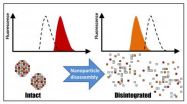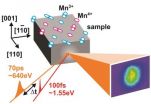(Press-News.org) Experimental studies have shown that deep brain stimulation (DBS) within the subcallosal cingulate (SCC) white matter of the brain is an effective treatment for many patients with treatment-resistant depression. Response rates are between 41 percent and 64 percent across published studies to date.
One of the proposed mechanisms of action is the modulation of a network of brain regions connected to the SCC. Identifying the critical connections within this network for successful antidepressant response is an important next step.
A new study using MRI analysis of the white matter connections examined the architecture of this network in patients who demonstrated significant response to SCC DBS. Researchers found that all responders showed a common pattern defined by three distinct white matter bundles passing through the SCC. Non-responders did not show this pattern.
The study is published online in the journal Biological Psychiatry, with the title "Defining Critical White Matter Pathways Mediating Successful Subcallosal Cingulate Deep Brain Stimulation for Treatment-Resistant Depression."
"This study shows that successful DBS therapy is not due solely to local changes at the site of stimulation but also in those regions in direct communication with the SCC," says Helen Mayberg, MD, senior author of the article, professor of psychiatry, neurology and radiology and the Dorothy C. Fuqua Chair in Psychiatric Imaging and Therapeutics at Emory University School of Medicine.
"Precisely delineating these white matter connections appears to be very important to a successful outcome with this procedure. From a practical point of view, these results may help us to choose the optimal contact for stimulation and eventually to better plan the surgical placement of the DBS electrodes."
Led by researchers at Emory University, Case Western Reserve University and Dartmouth University, the study included 16 patients with treatment-resistant depression who previously received SCC DBS at Emory. Computerized tomography was used post-operatively to localize the DBS contacts on each electrode. The activation volumes around the active contacts were modeled for each patient. Sophisticated neuroimaging combined with computerized analysis was used to derive and visualize the specific white matter fibers affected by ongoing DBS.
Therapeutic outcome was evaluated at six months and at two years. Six of the patients had responded positively to DBS at six months, and by two years these six plus six more patients responded positively. All shared common involvement of three distinct white matter bundles: the cingulum, the forceps minor and the uncinate fasciculus.
The conversion of six of the patients who were not responding at six months to being responders at two years was explained by the inclusion of all three bundles due to changes in stimulation settings. Non-responders at both six months and two years showed incomplete involvement of these three tracts.
"In the past, placement of the electrode relied solely on anatomical landmarks with contact selection and stimulation parameter changes based on a trial-and-error method," says Patricio Riva-Posse, MD, Emory assistant professor of psychiatry and behavioral sciences and first author of the paper. "These results suggest that clinical outcome can be significantly influenced by optimally modulating the response network defined by tractography. This obviously will need to be tested prospectively in additional subjects here and by other teams exploring the use of this experimental treatment."
This new information will allow us to develop a refined algorithm for guiding surgical implantation of electrodes and optimizing the response through fine tuning of stimulation parameters," notes Mayberg. "That said, improving anatomical precision alone doesn't account for all non-responders, so that is an important next focus of our research."
The researchers now plan to study DBS therapy in a prospective protocol of similar treatment-resistant depressed patients, using presurgical mapping of an individual patient's network structure, precisely targeting the three SCC fiber bundles, and systematically testing the stimulation contacts.
INFORMATION:Co-first author of the paper is Emory post doc and previous Georgia Tech graduate student Ki Sueng Choi. Other Emory authors are Robert Gross, Andrea Crowell, Steven Garlow and Justin Rajendra. Authors from Case Western Reserve are Cameron McIntyre and Ashutosh Chaturvedi, and from Dartmouth University, Paul Holtzheimer.
Precise brain mapping can improve response to deep brain stimulation in depression
2014-04-28
ELSE PRESS RELEASES FROM THIS DATE:
Wildfire outbreak in far eastern Russia
2014-04-28
According to the Voice of Russia, "As of Saturday morning, in Russia continue 103 wildfires at 27,412 hectares, including big 26 wildfires in the Far East and in Siberia. On Friday, 147 new fires began at 12,509 hectares, and 150 were extinguished at 5,437 hectares. Emergency situation has been introduced in the regions with most complicated situations - in the Amur region, in the Maritime and Baikal territories. This was according to the EMERCOM's (Emergency Control Ministry) spokesperson Alexander Drobyshevsky.
Satellites (such as Aqua and Terra) have located "1,587 ...
Cyberspace scholarship nets higher grades, better thinking for class Facebook group
2014-04-28
University students who used a Facebook group as part of a large sociology class did better on course assignments and felt a stronger sense of belonging, according to a Baylor University study.
The study has implications for the challenge of teaching large classes, a growing concern for higher education. Classes numbering hundreds of students — particularly in introductory courses — have become common at many universities, said researchers Kevin Dougherty, Ph.D., associate professor of sociology in Baylor's College of Arts and Sciences, and Brita Andercheck, a doctoral ...
Newborn Tropical Storm Tapah threatens Saipan and Tinian
2014-04-28
A tropical storm warning is in force for Saipan and Tinian as Tropical Storm Tapah moves north through the Northwestern Pacific Ocean on April 28. When NASA-NOAA's Suomi NPP satellite passed overhead and, imagery revealed a developing eye in Tapah.
In addition to the tropical storm warning, a typhoon watch is in effect for Alamagan and Pagan as Tapah is expected to continue in a generally northerly direction over the next couple of days. A typhoon watch means typhoon force winds of 74 mph or greater are possible within 48 hours. A tropical storm warning means tropical ...
Fluorescent-based tool reveals how medical nanoparticles biodegrade in real time
2014-04-28
Nanoparticles have been heralded as a potential "disruptive technology" in biomedicine, a versatile platform that could supplant conventional technologies, both as drug delivery vehicles and diagnostic tools.
First, however, researchers must demonstrate the properly timed disintegration of these extremely small structures, a process essential for their performance and their ability to be safely cleared out of a patient's body after their job is done. A new study presents a unique method to directly measure nanoparticle degradation in real time within biological environments.
"Nanoparticles ...
A glassy look for manganites
2014-04-28
Manganites – compounds of manganese oxides - show great promise as "go-to" materials for future electronic devices because of their ability to instantly switch from an electrical insulator to a conductor under a wide variety of external stimuli, including magnetic fields, photo-excitations and vibrational excitations. This ultrafast switching arises from the many different ways in which the electrons and electron-spins in a manganite may organize or re-organize in response to such external stimuli. Understanding the physics behind these responses is crucial for the future ...
Ozone levels drop 20 percent with switch from ethanol to gasoline
2014-04-28
A Northwestern University study by an economist and a chemist reports that when fuel prices drove residents of São Paulo, Brazil, to mostly switch from ethanol to gasoline in their flexible-fuel vehicles, local ozone levels dropped 20 percent. At the same time, nitric oxide and carbon monoxide concentrations tended to go up.
The four-year study is the first real-world trial looking at the effects of human behavior at the pump on urban air pollution. This empirical analysis of atmospheric pollutants, traffic congestion, consumer choice of fuel and meteorological conditions ...
Risk of cesarean delivery 12 percent lower with labor induction
2014-04-28
The risk of a cesarean delivery was 12% lower in women whose labour was induced compared with women who were managed with a "wait-and-see" approach (expectant management), according to a research paper published in CMAJ (Canadian Medical Association Journal).
Labour is induced in about 20% of all births for a variety of reasons such as preeclampsia, diabetes, preterm rupture of the membranes, overdue pregnancy and fetal distress. Induction is often thought to be associated with increased risk of cesarean deliveries despite evidence indicating a lower risk. However, much ...
Catastrophic thoughts about the future linked to suicidal patients
2014-04-28
Suicide has been on the increase recently in the United States, currently accounting for almost 40,000 deaths a year. A new study shows that one successful effort to avoid suicide attempts would be to focus on correcting the distorted, catastrophic thoughts about the future that are held by many who try to kill themselves. Such thoughts are unique and characteristic to those who attempt suicide, says Shari Jager-Hyman of the University of Pennsylvania Perelman School of Medicine in the US. Jager-Hyman led a study, published in Springer's journal Cognitive Therapy and ...
Identification of genetic mutations involved in human blood diseases
2014-04-28
A study published today in Nature Genetics has revealed mutations that could have a major impact on the future diagnosis and treatment of many human diseases. Through an international collaboration, researchers at the Montreal Heart Institute (MHI) were able to identify a dozen mutations in the human genome that are involved in significant changes in complete blood counts and that explain the onset of sometimes severe biological disorders.
The number of red and white blood cells and platelets in the blood is an important clinical marker, as it helps doctors detect many ...
Stanford scientists create circuit board modeled on the human brain
2014-04-28
The Neurogrid circuit board can simulate orders of magnitude more neurons and synapses than other brain mimics on the power it takes to run a tablet computer.
Stanford scientists have developed a new circuit board modeled on the human brain, possibly opening up new frontiers in robotics and computing.
For all their sophistication, computers pale in comparison to the brain. The modest cortex of the mouse, for instance, operates 9,000 times faster than a personal computer simulation of its functions.
Not only is the PC slower, it takes 40,000 times more power to run, ...



